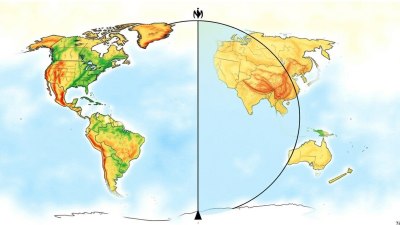How Seasons Are Different in the Northern and Southern Hemispheres
Explore the contrasting seasons of the Northern and Southern Hemispheres and understand why they occur at opposite times.

Image created with Flux Schnell
The Earth is divided into two halves by the equator: the Northern Hemisphere and the Southern Hemisphere. Each hemisphere experiences seasons, but intriguingly, these seasons do not coincide. When it is summer in the Northern Hemisphere, it is winter in the Southern Hemisphere, and vice versa. This article explores how and why seasons differ between these two hemispheres, examining the causes and effects of these seasonal variations around the globe.
The Earth's Tilt and Its Impact on Seasons
The fundamental reason for the differing seasons across hemispheres lies in the Earth's axial tilt. The Earth's axis is tilted approximately 23.5 degrees relative to its orbit around the sun. This tilt means that during different times of the year, either the Northern or Southern Hemisphere is tilted toward the sun, receiving more direct sunlight and experiencing warmer temperatures.
During the months when the Northern Hemisphere is tilted toward the sun, typically from June to September, it experiences longer days and warmer temperatures, marking its summer season. Simultaneously, the Southern Hemisphere is tilted away from the sun, resulting in shorter days, less solar energy, and cooler temperatures—thus, winter.
Conversely, from December to March, the Southern Hemisphere tilts toward the sun, enjoying its summer while the Northern Hemisphere experiences winter. This seesaw effect between the hemispheres means that their seasons are essentially reversed throughout the year.
Solstices and Equinoxes: Marking Seasonal Changes
The transition of seasons is closely linked to four key astronomical events: the two solstices and the two equinoxes. The solstices occur when the sun reaches its highest or lowest point in the sky at noon, marking the longest and shortest days of the year. The June solstice, around June 21, heralds summer in the Northern Hemisphere and winter in the Southern Hemisphere. Meanwhile, the December solstice, around December 21, brings winter to the north and summer to the south.
Equinoxes, around March 21 and September 23, occur when the Earth's axis is not tilted toward or away from the sun. This results in nearly equal day and night lengths worldwide. The March equinox signals the start of spring in the Northern Hemisphere and autumn in the Southern Hemisphere, while the September equinox brings autumn north and spring south.
Variation in Seasonal Experiences Between Hemispheres
While the timing of seasons is opposite, the intensity and characteristics of these seasons can differ significantly. The Northern Hemisphere contains most of the world's landmass and a greater variety of climates, from arctic to tropical zones. This large land proportion means it tends to heat up and cool down faster, creating more extreme seasonal temperature variations.
In contrast, the Southern Hemisphere consists largely of oceans, including vast bodies like the South Pacific, South Atlantic, and Indian Oceans. Water has a higher heat capacity than land, meaning it warms and cools more slowly, leading to milder seasonal temperature changes in southern regions.
Additionally, ocean currents influence seasonal weather patterns differently in each hemisphere. For example, the warm Gulf Stream affects the Northern Hemisphere’s east coast climate, while the Antarctic Circumpolar Current impacts the Southern Hemisphere's climate, distributing cold water and affecting sea temperatures.
Effects on Flora and Fauna
The seasonality differences influence ecosystems in each hemisphere. Plant life responds to temperature changes and daylight duration, leading to varied blooming and growth cycles. In the Northern Hemisphere, spring often commences with rapid plant growth after winter dormancy, while in the Southern Hemisphere spring starts six months later.
Animal behaviors, such as migration, hibernation, and breeding cycles, are also tuned to these seasonal shifts. Many birds migrate between hemispheres to take advantage of favorable climates and food availability. For instance, some species breed during northern summers and migrate south in the northern winter, capitalizing on the Southern Hemisphere’s summer conditions.
Human Activities and Cultural Variations
The reversal of seasons means that global cultural activities and holidays align differently depending on the hemisphere. For example, Christmas occurs in winter for those in the Northern Hemisphere, often associated with snow and cold weather. In contrast, people in the Southern Hemisphere experience Christmas during summer, frequently celebrating with beach gatherings and barbecues.
Agricultural practices also adjust to the seasonal calendar. Farmers plant crops according to seasonal temperatures, daylight, and rainfall patterns. For example, wheat is typically sown in the fall and harvested in summer, but this timeline is offset by six months between Northern and Southern Hemisphere farmers.
Unique Climatic Phenomena in Each Hemisphere
While the fundamental cause of seasonal differences remains the axial tilt, unique climatic phenomena further shape how seasons are experienced. The Northern Hemisphere experiences phenomena such as monsoons, which bring seasonal rains crucial to agriculture in countries like India. These monsoon patterns arise partly due to continental landmass and ocean interactions.
The Southern Hemisphere experiences phenomena like the austral summer, affecting countries like Australia and New Zealand with warmer temperatures and wet seasons. The Antarctic winter, occurring during the Northern Hemisphere’s summer, brings extreme cold and darkness due to polar night, influencing global climate systems.
How Climate Change Is Affecting Seasonal Patterns
Climate change does not alter the Earth's tilt or the timing of solstices and equinoxes, but it is affecting how seasons manifest. In both hemispheres, seasonal temperature patterns are shifting due to global warming. Winters have become milder in many northern regions, and summer heat waves have increased in both hemispheres.
Changes in precipitation patterns affect growing seasons, water availability, and ecosystem balances. These shifts can disrupt traditional agricultural calendars, impacting food security. Additionally, earlier springs and delayed autumns in the Northern Hemisphere change when plants bloom and birds migrate, potentially affecting entire food chains.
In the Southern Hemisphere, the rapid warming of Antarctica and surrounding oceans influences seasonal weather extremes and ice melt patterns. This warming contributes to rising sea levels worldwide, a global concern transcending hemispheric boundaries.
Observing Seasons from the Equator
Interestingly, regions near the equator experience minimal seasonal changes compared to the hemispheres farther north or south. Here, temperatures remain relatively stable year-round, and instead of four seasons, many equatorial locations experience wet and dry seasons. This difference results from consistent solar radiation near the equator, without the axial tilt significantly altering day length or solar angles throughout the year.
However, even equatorial regions can feel the indirect effects of hemispheric seasons, such as shifts in wind patterns and rainfall linked to seasonal cycles in the hemispheres. For example, the Intertropical Convergence Zone (ITCZ) migrates north and south with the sun, affecting equatorial rainfall and seasonality.
The Significance of Understanding Seasonal Differences
Recognizing how seasons differ between hemispheres enhances our understanding of global climate, ecosystems, and human culture. It informs travel planning, agriculture, environmental conservation, and international trade. Tourism industries capitalize on hemispheric seasonality, promoting winter sports in the Northern Hemisphere's colder months and beach vacations in the Southern Hemisphere's summer.
Research into seasonal differences also aids scientists studying climate change impacts. Models predicting future climate scenarios depend on accurate knowledge of seasonal cycles and their responses to warming.
Ultimately, these contrasts remind us of the complexity and interconnectedness of Earth's systems. The opposing cycles of the hemispheres underscore the delicate balance maintained by the planet’s axial tilt and orbit, shaping life in diverse ways across every continent and ocean.










